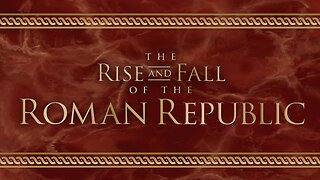Premium Only Content

The Italian Renaissance | Neoplatonism (Lecture 19)
Lecture 19: The Humanists, beginning with Petrarch, largely rejected the philosophy and the methodology of the Middle Ages known as Scholasticism, that is, the application of Aristotelian logic to theology. This did not mean that they rejected the original writings of either Aristotle or his teacher, Plato. On the contrary, both enjoyed great status as classical writers. Many of the dialogues of Plato were only just becoming available with the spread of Greek texts in the late 14th and early 15th centuries; thus, there was a sense of novel discovery. Even more important, Platonism had had a substantial influence on early Christianity. Such concepts as the immortality of the soul and the interconnection of all creation had deep roots in Platonic thought.
The impetus to institutionalize Neoplatonism in the Renaissance was Cosimo de’Medici’s decision to commission the young scholar Marsilio Ficino (d. 1499) to translate the Platonic corpus into Latin. Soon, Ficino gathered around him a group of learned laymen and scholars whose interest in Plato turned his study into a kind of court; its members included such luminaries as Lorenzo the Magnificent, Angelo Poliziano (d. 1494), and Giovanni Pico della Mirandola (d. 1494), as well as such artists as Botticelli (d. 1510) and Michelangelo (d. 1564).
Primary Source Texts:
Kenneth R. Bartlett, “Florentine Neoplatonism and Mysticism,” pp. 117–137, in The Civilization of the Italian Renaissance.
Secondary Sources:
James Hankins, Plato in the Italian Renaissance.
Supplementary Reading:
Nesca A. Robb, Neoplatonism of the Italian Renaissance.
Lecture 20: https://rumble.com/v4y40gl-the-italian-renaissance-milan-under-the-visconti-lecture-20.html
-
 14:25
14:25
The Great Courses
1 month agoThe Rise And Fall Of The Roman Republic | The Importance of Rome (Lecture 1)
297 -
 1:20:58
1:20:58
Russell Brand
3 hours agoWoah! Dan Crenshaw REALLY HATES Tucker Carlson: Dan Explains Why – SF553
73.5K69 -
 DVR
DVR
vivafrei
2 hours agoKash Patel GOES NUCLEAR on Petty Crime? Canada GOES NUCLEAR on U.S. Bourbon! & MORE!
17.4K16 -
 LIVE
LIVE
The Tom Renz Show
47 minutes agoDOGE & Immigration vs. Epstein, Health & mRNA? How are we doing?
221 watching -
 LIVE
LIVE
Akademiks
3 hours agoDay 1/30. PLAYBOI CARTI 'I AM MUSIC' PRE STREAM.
2,957 watching -
 DVR
DVR
Simply Bitcoin
2 hours ago $0.24 earnedHe Wasn't Meant To Say This: Bitcoin Hits $1M in The Next 48 Months! | EP 1202
2.03K -
 34:25
34:25
CryptoWendyO
45 minutes agoHUGE REASONS XRP AND ETHEREUM COULD PUMP TO NEW HIGHS IN MARCH
1 -
 53:54
53:54
The Dan Bongino Show
4 hours agoBitter Dems Move To Shutdown Government (Ep. 2441) - 03/13/2025
498K1.06K -
 56:37
56:37
Grant Stinchfield
2 hours ago $1.49 earnedNational Security Put at Risk... Biden Personal Emails Discovered Containing the Unthinkable!
15.4K1 -
 3:12
3:12
Gun Drummer
1 day agoMetallica - Enter Sandman GUN COVER
654